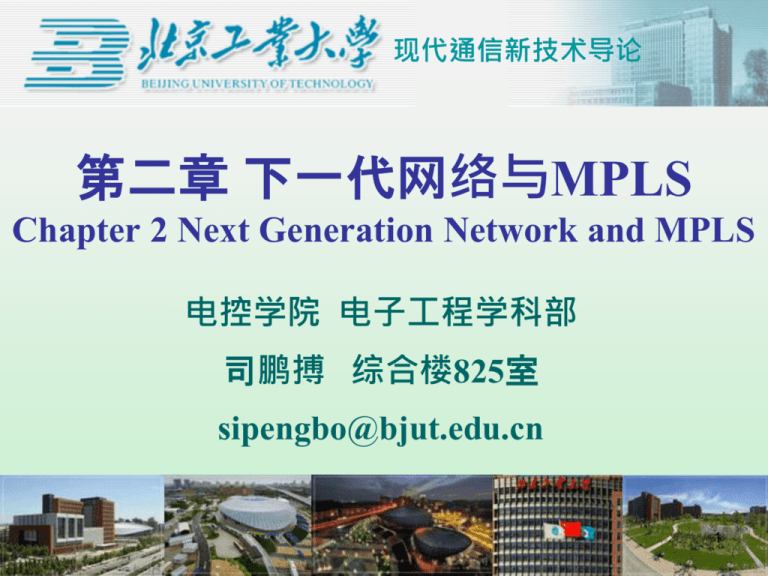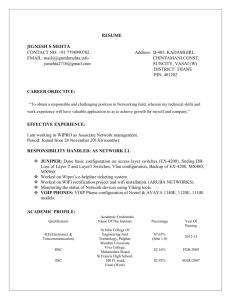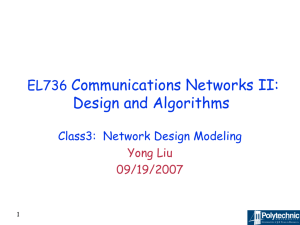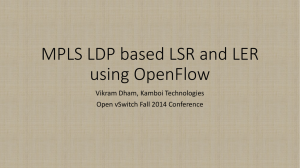16 现代通信新技术导论第二章下一代网络与MPLS
advertisement

现代通信新技术导论 第二章 下一代网络与MPLS Chapter 2 Next Generation Network and MPLS 电控学院 电子工程学科部 司鹏搏 综合楼825室 sipengbo@bjut.edu.cn 1 现代通信新技术导论 第二章 下一代网络与MPLS Main Contents • Next Generation Network – – – – Background of Next Generation Network (NGN) Definition of NGN Characteristics of NGN Architectures of NGN • 3GPP • ETSI • With Softswitch • MPLS 2 现代通信新技术导论 第二章 下一代网络与MPLS Main Contents • Next Generation Network • MPLS – Need for MPLS – MPLS Architecture • Label Switching • MPLS Basics – MPLS Labels • • • • • Label Forwarding Label Distribution and Management MPLS Forwarding Table LSP Loop Detection LDP 3 现代通信新技术导论 第二章 下一代网络与MPLS Main Contents • Next Generation Network – – – – Background of Next Generation Network (NGN) Definition of NGN Characteristics of NGN Architectures of NGN • 3GPP • ETSI • With Softswitch • MPLS 4 现代通信新技术导论 第二章 下一代网络与MPLS Background of NGN • Limited Capacity of Traditional Internet – Simple services are not sufficient • Voice, text message, e-mail – Non-open system – Different networks are independent – Old technologies are not ready for evolution • Why Next Generation Network? – – – – The fast growing of data service requirement The slow growing/decreasing of voice service The increasingly cut-throat competition The rapid development of new technologies 5 现代通信新技术导论 第二章 下一代网络与MPLS Video Movies Music Ring tone Photos Person-to-Content known usability patterns Internet Text/Pictures Streaming Download Multimedia Content HTTP Video SMS/MMS Active phonebook Person-to-Person Image dominates traffic growth Social Networking Text P2P Calls Voice Presence Push-To-Talk MMS SMS Voice 6 现代通信新技术导论 第二章 下一代网络与MPLS 7 现代通信新技术导论 第二章 下一代网络与MPLS Societal and Business trends Convergence • Internet is becoming a major enabler of communications • Converged devices (Mobile, WLAN, Internet etc.) Connectivity • Consumers are embracing computing, mobile and digital technology in their everyday life • Converged services Ease of use • Evolution of Business models require increased levels of personal mobility • Converged business models Increased margins, Avoidance of twin pitfalls risk • Converged networks Reliability, Security, Reduced OPEX/CAPEX Access Technology Enhancements • HSPA (High Speed Packet Access) – evolved WCDMA • OFDMA (Orthogonal Frequency Division Multiple Access) – 3GPP LTE, WiMAX, MBWA, ADSL/VDSL, DVB-T/H etc. • Spatial Processing – multi-antennas Base Stations supporting advanced spatial processing 8 现代通信新技术导论 第二章 下一代网络与MPLS Main Contents • Next Generation Network – – – – Background of Next Generation Network (NGN) Definition of NGN Characteristics of NGN Architectures of NGN • 3GPP • ETSI • With Softswitch • MPLS 9 现代通信新技术导论 第二章 下一代网络与MPLS Definition of NGN • By ITU-T – In Feb. 3 - 12, 2004, ITU-T SG13 – A Next Generation Network is a packet-based network able to provide telecommunication services, able to make use of multiple broadband, QoS-enabled transport technologies and in which service-related functions are independent from underlying transportrelated technologies. – It offers unrestricted access by users to different service providers. – It supports generalized mobility which will allow consistent and ubiquitous provision of services to users. 10 现代通信新技术导论 第二章 下一代网络与MPLS Definition of NGN Support Broad Variety of Services Openess and Flexibility Regarding New Services Packet Oriented Network NGN CONCEPT Seperation into Different Layers Using Open Interfaces Integration of Existing Infrastructure Application Focused Access Independent 11 现代通信新技术导论 第二章 下一代网络与MPLS Main Contents • Next Generation Network – – – – Background of Next Generation Network (NGN) Definition of NGN Characteristics of NGN Architectures of NGN • 3GPP • ETSI • With Softswitch • MPLS 12 现代通信新技术导论 第二章 下一代网络与MPLS Characteristics of NGN • Packet-based transfer • Separation of control functions • Decoupling of service provision • Support for a wide range of services • Broadband capabilities with end-to-end QoS • Interworking via open interfaces • Generalized mobility 13 现代通信新技术导论 第二章 下一代网络与MPLS Characteristics of NGN • Unrestricted access • A variety of identification schemes • Unified service characteristics • Converged services between Fixed/Mobile • Independence of service-related functions • Support of multiple RATs • Compliant with all regulatory requirements 14 现代通信新技术导论 第二章 下一代网络与MPLS Main Contents • Next Generation Network – – – – Background of Next Generation Network (NGN) Definition of NGN Characteristics of NGN Architectures of NGN • 3GPP • ETSI • With Softswitch • MPLS 15 现代通信新技术导论 第二章 下一代网络与MPLS Architecture Evolution Traditional Architecture 16 现代通信新技术导论 第二章 下一代网络与MPLS Architecture Evolution 17 现代通信新技术导论 第二章 下一代网络与MPLS Architecture Evolution 18 现代通信新技术导论 第二章 下一代网络与MPLS Architecture Evolution Pol. A Reg. a Pol. B Reg. b Service-based Pol./Reg. Pol. C Reg. c Voice Internet Video Phone Internet M-Ph NGN PSTN IP-Net MM Pol. Reg. Mobile IP (Future Packet ?) Platform Pol. X Reg. x xDSL/Optic based Fixed-Mobile Resource-based Pol./Reg. Current PolicyRegulation Environment (Vertical) New PolicyRegulation Environment (Horizontal) 19 现代通信新技术导论 第二章 下一代网络与MPLS Architecture Evolution 20 现代通信新技术导论 第二章 下一代网络与MPLS Architecture Evolution 21 现代通信新技术导论 第二章 下一代网络与MPLS The Players of NGN ITU-T NGN FG ATIS NGN FG ETSI TISPAN1 3GPP 22 现代通信新技术导论 第二章 下一代网络与MPLS Main Contents • Next Generation Network – – – – Background of Next Generation Network (NGN) Definition of NGN Characteristics of NGN Architectures of NGN • 3GPP • ETSI • With Softswitch • MPLS 23 现代通信新技术导论 第二章 下一代网络与MPLS 3GPP Architecture of NGN with IMS 24 现代通信新技术导论 第二章 下一代网络与MPLS 3GPP Architecture of NGN with IMS • IMS is an open IP-based architecture using the Client-Server Network Computing model – 3GPP originally specified IMS to enable real-time multimedia services over the IP bearer, in GSM and WCDMA networks. – 3GPP2 specified the MMD architecture for CDMA2000 networks based on IMS. 3GPP2 requirements are part of Common IMS in IMS release 8. – The xDSL access, specified by TISPAN, is integrated into IMS. – The cable access specified by CableLabs in PacketCable 2.0 is part of IMS release 8. – Interworking with WLAN was specified in IMS release 6, while the mobility with WiMAX has been addressed in EPC specifications. • If IMS is not used: – Multimedia communication at best effort – Service roaming can be difficult to implement – Provisioning and charging are service specific – Compliance with LI requirements can be an issue 25 现代通信新技术导论 第二章 下一代网络与MPLS Main Contents • Next Generation Network – – – – Background of Next Generation Network (NGN) Definition of NGN Characteristics of NGN Architectures of NGN • 3GPP • ETSI • With Softswitch • MPLS 26 现代通信新技术导论 第二章 下一代网络与MPLS ETSI TISPAN NGN Architecture 27 现代通信新技术导论 第二章 下一代网络与MPLS NGN Architecture Principles • A Layered Approach Including – A transport layer, including functional entities that do transport routing – A service layer, including functional entities that provide services • A Sub-System Oriented Approach Enabling – The addition of new subsystems over the time to cover new demands and service classes – To import (and adapt) subsystems from other standardization bodies – Flexibility to adjust a subsystem architecture with no or limited impact on other subsystems 28 现代通信新技术导论 第二章 下一代网络与MPLS NGN Architecture Principles • IP Connectivity is Provided Using Two Sub-Systems: – Network Attachment Subsystem (NASS) – Resource and Admission Control Subsystem (RACS) • First Service-Oriented Sub-Systems Include – the 3GPP IMS, a PSTN/ISDN Simulation Sub-system – a PSTN/ISDN Emulation Subsystem (PES) • Future Service-Oriented Sub-Systems may Include – A streaming subsystem – A TV Broadcasting subsystem 29 现代通信新技术导论 第二章 下一代网络与MPLS 30 现代通信新技术导论 第二章 下一代网络与MPLS Common Components • Common components are functions that are used by more than a subsystem – USPF: User Profile Server Function – Service-level user identification, numbering, and addressing information – Service-level user security information – Service-level user location information – Service-level user profile storage – The IMS part of the USPF is similar to the 3GPP HSS without the HLR/AUC 31 现代通信新技术导论 第二章 下一代网络与MPLS Common Components • ASF: Application Server Function – Offers services – Two types of ASFs: • Type 1: may interact with RACS for resource control purposes • Type 2: relay on the control subsystem. – Type 2 is equivalent to the Application Server defined by 3GPP IMS • SLF: Subscription Locator Function – Helps locating the USPF of a given user – Like the SLF defined by 3GPP IMS 32 现代通信新技术导论 第二章 下一代网络与MPLS Common Components • Charging Functions – Data collection functions and mediation functions to the billing systems – Both on-line and off-line charging • IWF: Interworking Function – Between different SIP profiles – Between SIP and H.323 • IBCF: Interconnection Border Control Function – – – – Controls an operator’s boundary Interacts with RACS Inserts IWF when appropriate Screening of signaling based on source/destination addresses 33 现代通信新技术导论 第二章 下一代网络与MPLS 34 现代通信新技术导论 第二章 下一代网络与MPLS Transfer Functions 35 现代通信新技术导论 第二章 下一代网络与MPLS Transfer Functions • BGF: Border Gateway Function – Interface between two IP transport domains – Open/close gates, packet marking, resource allocation, bandwidth reservation, NAPT, NAT traversal, incoming traffic policing, usage metering, IPv4/IPv6 interworking, topology hiding – Three types of BGF: • A-BGF (Access-BGF): located in between access and core network, at the access network side • C-BGF (Core-BGF): located in between access and core network, at the core network side • I-BGF (Interconnection-BGF): located in between two core networks 36 现代通信新技术导论 第二章 下一代网络与MPLS Transfer Functions • L2TF: Layer 2 Termination Function – Terminates Layer 2, e.g., PPP or DSLAM • ARF: Access Relay Function – Relay between the CPE and the NASS – Located in the access network – Resource reservation and admission control • SGF: Signaling Gateway Function – Conversion of SS7 protocols to IP control protocols (e.g., SIP) – SS7 screening of MTP and SCCP parameters 37 现代通信新技术导论 第二章 下一代网络与MPLS Transfer Functions • MGF: Media Gateway Function – Media mapping and transcoding between IP and CS networks – Three types of MGF: • R-MGF Residential MGF: located in the customer premises • A-MGF Access MGF: located in the access or core network • T-MGF Trunking: MGF located in the boundary of the core network and PSTN/ISDN network • MRFP: Media Resource Function Processor – Multimedia conferences, media sourcing, IVR capabilities, media content analysis 38 现代通信新技术导论 第二章 下一代网络与MPLS 39 现代通信新技术导论 第二章 下一代网络与MPLS RACS Functionality • Support for Two Types of QoS: – Guaranteed QoS: resources are reserved – Support for Relative QoS: diffserv marking • Service Based Local Policy Control: authorization of QoS requests and definition of the polices to be enforced by the bearer service network elements. – Resource reservation – Support for two mechanisms • Application Function (AF)-initiated • CPE-initiated (Authorization token a la 3GPP). – QoS support over multiple access networks (e.g. ADSL and GPRS) and CPE types. 40 现代通信新技术导论 第二章 下一代网络与MPLS RACS Functionality • Admission Control: Apply admission control to resource reservation requests – Based on knowledge of transport resource availability over the “last-mile access” and aggregation segments of the access network • NAPT/ Gate Control: controls near-end and far-end NAPT and FW functions, when required, between: – two core TISPAN NGN networks or, – at the border between core and access TISPAN NGN networks 41 现代通信新技术导论 第二章 下一代网络与MPLS RACS Architecture 42 现代通信新技术导论 第二章 下一代网络与MPLS RACS Architecture • SPDF: Service-based Policy Decision Function – Provides to AF a single point of contact – Authorization decision for QoS resource • A-RACF: Access Resource and Admission Control Function – Located in the access network – Resource reservation and admission control – In Guaranteed QoS mode, it sets L2/L3 QoS policies in RCEF – In Relative QoS mode, it sets dynamically the diffserv QoS parameters in RCEF 43 现代通信新技术导论 第二章 下一代网络与MPLS RACS Architecture • C-BGF: Core Border Gateway Function – Essentially, an edge router – Located at the border of networks (access/core – core/core) – NAPT, Gate Control, packet marking, usage metering, policing enforcement function – SPDF controls the gates of the C-BGF based on a 5-tuple (source and destination IP addr., source and destination port numbers, protocol) • RCEF: Resource Control Enforcement Function – Performs policy enforcement under the control of the A-RACF – Located in the access network – Gate control, packet marking, policing – A-RACF controls the gates of the RCEF based on a 5-tuple (source and destination IP addr., source and destination port numbers, protocol) 44 现代通信新技术导论 第二章 下一代网络与MPLS RACS Architecture • L2TF: Layer 2 Termination Functions – Layer 2 (e.g., PPP, ATM) is terminated here – Authorization decision for QoS resource • AF: Application Function – Officially, not part of RACS. Just a RACS user – Requests bearers resources, gest informed when resources are reserved and released – It is specific of the application. E.g., P-CSCF in IMS 45 现代通信新技术导论 第二章 下一代网络与MPLS 46 现代通信新技术导论 第二章 下一代网络与MPLS NASS Functionality • Dynamic provision of IP address and other user equipment configuration parameters (e.g., using DHCP) • User authentication, prior or during the IP address allocation procedure • User authentication based on user network profile – Based on PPP, IEEE 802.11X or IETF PANA 47 现代通信新技术导论 第二章 下一代网络与MPLS NASS Functionality • Line authentication based on Layer 2 line identification • Location management (e.g. for emergency call, …) • Customer Premises Equipment configuration • The NASS can be distributed between a visited and a home network – Allows nomadicity and roaming • P-CSCF announcement 48 现代通信新技术导论 第二章 下一代网络与MPLS NASS Architecture 49 现代通信新技术导论 第二章 下一代网络与MPLS NASS Architecture • Network Address Configuration Function (NACF): – IP address allocation to the CPE – Distribution of other network configuration parameters such as address of DNS server(s), address of signaling proxies for specific protocols (e.g., PCSCF) – Typically implemented as RADIUS servers or DHCP servers • Access Management Function (AMF): – Translates network access signaling between CPE and NACF/UAAF – Forwards requests to he UAAF to authenticate the user, authorize/deny network access, and retrieve user-specific access configuration parameters – Typically implemented as RADIUS client if the NACF is a RADIUS server. 50 现代通信新技术导论 第二章 下一代网络与MPLS NASS Architecture • Connectivity Session Location Repository Function (CLF): – Registers association between the IP configuration of the CPE and – access transport characteristics, line identifier, IP edge identity, geographical location, etc. – Provides user network profile information to the RACS. – Provides location information to TISPAN NGN core subsystems • User Access Authorization Function (UAAF): – Performs user authentication and authorization based on user profiles – Collects accounting data 51 现代通信新技术导论 第二章 下一代网络与MPLS NASS Architecture • Profile Database Function (PDBF): – Stores the user network profile, containing • User identity • Supported authentication methods • Keys – Can be co-located with the UPSF • Customer Premises Equipment Configuration Function (CPECF): – Provides the CPE with additional initial configuration information (firewall, diffserv packet marking, etc.) • Customer Network Gateway (CNG): – Single point of entrance in the customer’s network (e.g., ADSL router) – Participates in line and access authentication 52 现代通信新技术导论 第二章 下一代网络与MPLS Service Layer • Modular Subsystem design • Two subsystem targeted in NGN Release 1: – PSTN/ISDN Emulation Subsystem (PES) • Emulates the PSTN/ISDN, users don’t notice the change • Support for legacy equipment including black phones – PSTN/ISDN Simulation Subsystem (a.k.a. IMS) • Multimedia terminals, new services based on the IMS model. • Includes PSTN/ISDN simulation services (similar to the PSTN/ISDN Supplementary Services) • Other subsystem may come in future NGN releases – Streaming Subsystem – Content Broadcasting Subsystem – Others as needed 53 现代通信新技术导论 第二章 下一代网络与MPLS 54 现代通信新技术导论 第二章 下一代网络与MPLS IMS Architecture in NGN 55 现代通信新技术导论 第二章 下一代网络与MPLS NGN Impacts to IMS • IMS can be mostly reused, as specified by 3GPP, due to its large access independence • A few changes are required: – NAT traversal support in various points – Relaxation of IMS constraints: • SIP compression is no longer mandatory • SIP timers are not “wireless” specific • SIP preconditions (183, PRACK, UPDATE) are no longer mandatory • Support for ADSL access in P-Access-Network-Info header 56 现代通信新技术导论 第二章 下一代网络与MPLS IMS Architecture • Call Session Control Function (CSCF): – Establishes, monitors, supports and releases multimedia functions – Three types of CSCFs: P-CSCF, I-CSCF, S-CSCF (same as in 3GPP IMS) – But P-CSCF contains also: • Application Level Gateway (ALG) to interface NAPT • Interfaces the NASS to retrieve user’s physical location • Media Gateway Control Function (MGCF): – Controls a T-MGW – Converts ISUP to SIP – Functionality is equal to the 3GPP IMS MGCF 57 现代通信新技术导论 第二章 下一代网络与MPLS IMS Architecture • Multimedia Resource Function Controller (MRFC): – Controls an MRFP – Together with the MRFP provides conference services, announcement playback, and media transcoding – Functionality is equal to the 3GPP IMS MRFC • Breakout Gateway Control Function (BGCF): – Selects the network in which PSTN breakout is to occur – Or selects the MGCF – Equal to the 3GPP IMS BGCF 58 现代通信新技术导论 第二章 下一代网络与MPLS PSTN/ISDN Simulation Services • ETSI TISPAN considers two types of IMS services: – Basic PSTN/ISDN Simulation Services: • Similar (but not equal) to PSTN/ISDN Supplementary Services • Unlike in the PSTN, not all these services require network support • Services must interwork with the similar PSTN/ISDN supplementary service and 3GPP supplementary service 59 现代通信新技术导论 第二章 下一代网络与MPLS PSTN/ISDN Simulation Services • Multimedia services: – New services, e.g., presence, multimedia instant messaging, SIP services that do not require extra standardization effort • PSTN/ISDN Simulation Services defined in NGN Release 1 with three priorities: – Mandatory services – Strictly recommended services – Optional services 60 现代通信新技术导论 第二章 下一代网络与MPLS Main Contents • Next Generation Network – – – – Background of Next Generation Network (NGN) Definition of NGN Characteristics of NGN Architectures of NGN • 3GPP • ETSI • With Softswitch • MPLS 61 现代通信新技术导论 第二章 下一代网络与MPLS NGN Architecture with Softswitch 62 现代通信新技术导论 第二章 下一代网络与MPLS Access Layer • Functions of access layer – Connecting subscribers, AN & PABX and trunks from PSTN, ISDN, and PLMN, etc – Converting the format of information (circuits to packet or packet to circuit) before transmitting it. • Components on the access layer – IP terminals (IP phones, IP PBX and software phones, typically intelligent terminals based on either H.323 or SIP) – Integrated access device (IAD) (used to access subscribers (analog, ADSL, IP) in the NGN. Accesses data of subscriber terminals, voice services and video services to the packet network) 63 现代通信新技术导论 第二章 下一代网络与MPLS Access Layer – Access gateway (AGW) (acts as the interface to the core IP network and connects subscribers with analog subscriber access, integrated services digital network (ISDN) subscriber access, PABX and x digital subscriber line (xDSL) access) – Access network (AN) (provides connectivity between the customer premises equipment and the access gateways in the service provider's network) – Access technologies could be cable, xDSL, wireless, optical, ... – SIP phone (a multimedia device working in the session initiation protocol (SIP)) 64 现代通信新技术导论 第二章 下一代网络与MPLS Access Layer – H. 323 phone (a multimedia device working in the H.323 protocol) – Signaling gateway (SG) (provides signaling interface between the IP network and the PSTN signaling network, terminates SS7 links and provides message transport part (MTP) Level 1 and Level 2 functionality) – Trunk Media gateway (TMG) (resides between the CS network and the IP network, converts format between PCM signal flow and IP media flow, and connects devices such as PSTN exchange, PBX and BSC) 65 现代通信新技术导论 第二章 下一代网络与MPLS Access Layer – Session border controller (SBC) (located at the administrative boundary of an IP network) for enforcing policy on multimedia sessions). The functions of SBC are • Interworking • Security • Management of service level agreements • Overload control • NAT and firewall traversal • lawful interception • QoS management • Protocol translation • Call accounting 66 现代通信新技术导论 第二章 下一代网络与MPLS NGN Architecture with Softswitch 67 现代通信新技术导论 第二章 下一代网络与MPLS Transport Layer • Composed of devices such as routers and Layer 3 switchers located in the backbone networks • Packet switching • Provides common and integrated platform for data transport • Ensures – High reliability – QoS assurance – High Capacity 68 现代通信新技术导论 第二章 下一代网络与MPLS NGN Architecture with Softswitch 69 现代通信新技术导论 第二章 下一代网络与MPLS Control Layer • Adopts software switching technologies to achieve – Primary real-time call control – Connection control • Functions of softswitch – – – – – – – – Call control Media gateway access control Signaling gateway control Border gateway control Resource allocation Protocol processing Routing Authentication and charging 70 现代通信新技术导论 第二章 下一代网络与MPLS NGN Architecture with Softswitch 71 现代通信新技术导论 第二章 下一代网络与MPLS Service Layer • The components are – Operation support system (OSS) • Integrated charging, network operation and management – Application server • Produces and manages value-added services and IN services • Provides a platform for third-party services • Helps to develop supplementary services 72 现代通信新技术导论 第二章 下一代网络与MPLS Service Layer – Media server (MS) • Service tone playing, conference services, IVR, recorded announcement, … – Service control point (SCP) • Stores subscriber data and service logics • Helps to realize various intelligent calls – Video server • Schedules, manages and provides video conferences 73 现代通信新技术导论 第二章 下一代网络与MPLS Main Contents • Next Generation Network • MPLS – Need for MPLS – MPLS Architecture • Label Switching • MPLS Basics – MPLS Labels • • • • Label Forwarding Label Distribution and Management LSP Loop Detection LDP 74 现代通信新技术导论 第二章 下一代网络与MPLS Conventional IP Networks & Routing • Client networks are connected to backbone via edge routers – LAN, PSTN, ADSL • Data packets are routed based on IP address and other information in the header • Functional components – Forwarding • Responsible for actual forwarding across a router • Consists of set of procedures to make forwarding decisions – Control • Responsible for construction and maintenance of the forwarding table • Consists of routing protocols such as OSPF, BGP and PIM 75 现代通信新技术导论 第二章 下一代网络与MPLS Need for MPLS • Forwarding function of a conventional router – A capacity demanding procedure – Constitutes a bottle neck with increase in line speed • MPLS simplifies forwarding function – By introducing a connection oriented mechanism inside the connectionless IP networks 76 现代通信新技术导论 第二章 下一代网络与MPLS Main Contents • Next Generation Network • MPLS – Need for MPLS – MPLS Architecture • Label Switching • MPLS Basics – MPLS Labels • • • • Label Forwarding Label Distribution and Management LSP Loop Detection LDP 77 现代通信新技术导论 第二章 下一代网络与MPLS Why MPLS R X X Router ATMControl Switch Plane: MPLS Router Forwarding Plane: IP Connectionless Oriented Connectionless Oriented Layer 3 routing: Scalability and flexibility Weak requirement of network topology Layer 2 routing: Reliability and QoS guarantee L3 routing Low efficiency of routing Poor QoS Control Plane: Forwarding Plane: MPLS Connectionless Oriented Connection Oriented ATM Control Plane: Connection Oriented L2 routing QoS guarantee provided N2 problem exists Forwarding Plane: Connection Oriented 78 现代通信新技术导论 第二章 下一代网络与MPLS MPLS Architecture LER MPLS Domain IP LER LSR LSR LER LSP LSR MPLS LER • LSR:Label Switch Router • LER:Label Edge Router • LSP:Label Switch Path 79 现代通信新技术导论 第二章 下一代网络与MPLS MPLS Architecture Core LSR LER LER IP IP Traditional IP Forwarding L1 IP L2 Label Forwarding IP L3 IP Traditional IP Forwarding 80 现代通信新技术导论 第二章 下一代网络与MPLS Main Contents • Next Generation Network • MPLS – Need for MPLS – MPLS Architecture • Label Switching • MPLS Basics – MPLS Labels • • • • Label Forwarding Label Distribution and Management LSP Loop Detection LDP 81 现代通信新技术导论 第二章 下一代网络与MPLS Label Switching • Decomposition of network layer routing into control and forwarding components • Label switching forwarding component algorithm uses – Forwarding table – Label carried in the packet • What is a Label? – Short fixed length entity 82 现代通信新技术导论 第二章 下一代网络与MPLS Main Contents • Next Generation Network • MPLS – Need for MPLS – MPLS Architecture • Label Switching • MPLS Basics – MPLS Labels • • • • Label Forwarding Label Distribution and Management LSP Loop Detection LDP 83 现代通信新技术导论 第二章 下一代网络与MPLS MPLS Basics • A Label Switched Path (LSP) is set up for each route • A LSP for a particular packet P is a sequence of routers, <R1, R2, …, Rn> for all i, 1< i < n, Ri transmits P to Ri+1 • Edge routers – Analyze the IP header to decide which LSP to use – Add a corresponding local Label Switched Path Identifier, in the form of a label – Forward the packet to the next hop 84 现代通信新技术导论 第二章 下一代网络与MPLS MPLS Basics • Subsequent nodes – Just forward the packet along the LSP – Simplify the forwarding function greatly – Increase performance and scalability dramatically • New advanced functionality for QoS, differentiated services can be introduced in the edge routers • Backbone can focus on capacity and performance • Routing information obtained using a common intra domain routing protocol such as OSPF 85 现代通信新技术导论 第二章 下一代网络与MPLS TTL of MPLS One hop for the whole MPLS domain IP TTL -MPLS TTL=255 MPLS TTL -- Entrance LER LSR IP TTL -- Exit LER Count MPLS TTL to IP TTL IP TTL -MPLS TTL=IP TTL MPLS TTL -- MPLS TTL -IP TTL=MPLS TTL Entrance LER LSR Exit LER 86 现代通信新技术导论 第二章 下一代网络与MPLS Main Contents • Next Generation Network • MPLS – Need for MPLS – MPLS Architecture • Label Switching • MPLS Basics – MPLS Labels • • • • Label Forwarding Label Distribution and Management LSP Loop Detection LDP 87 现代通信新技术导论 第二章 下一代网络与MPLS MPLS Frame Format and Label 20 0 Label L2 Header 23 24 EXP S MPLS Header IP Header 31 TTL Data • For ATM and FR – shim mode/frame mode – Cell mode: VC (VPI/VCI for ATM and DLCI for FR) as the label 88 现代通信新技术导论 第二章 下一代网络与MPLS The Location of Label Ethernet/SONET/SDH Header Lable L3 Data ATM Header Lable L3 Data Frame mode, ATM Cell mode, ATM VPI/VCI L3 Data 89 现代通信新技术导论 第二章 下一代网络与MPLS Label Stack L2 Header MPLS Header MPLS Header MPLS Header IP Header … Data • Theoretically, the nest of label stack is unlimited to provide unlimited capacity supporting new services. 90 现代通信新技术导论 第二章 下一代网络与MPLS Main Contents • Next Generation Network • MPLS – Need for MPLS – MPLS Architecture • Label Switching • MPLS Basics – MPLS Labels • • • • Label Forwarding Label Distribution and Management LSP Loop Detection LDP 91 现代通信新技术导论 第二章 下一代网络与MPLS The Concept of Label Forwarding • FEC(Forwarding Equivalence Class) – Use the same LSP for packets with similar or identical characteristics (bound to the same label) • NHLFE(Next Hop Label Forwarding Entry) – Includes the information of the next hop – Action types: push/pop/swap/null • FTN(FEC to NHLFE) – Mapping FEC to NHLFE • ILM(Incoming Label Map) – Mapping MPLS label to NHLFE 92 现代通信新技术导论 第二章 下一代网络与MPLS Label Forwarding Action: pop Action: push Bind LSP according to the IP Header FTN->NHLFE Action: swap ILM->NHLFE E1 ILM->NHLFE E2 A Entrance LER ILM->NHLFE Find out the next hop according to the IP Header Action: swap E3 B LSR C LSR D Exit LER A: FEC 10.0.1.0/24 NHLFE Next Hop Send to Action Others B E1 Push L1 … • To establish a LSP: With routing protocol and LDP, build the routing table and FEC-Label mapping for FECs • Push the Labels for different FECs 93 现代通信新技术导论 第二章 下一代网络与MPLS Label Forwarding Action: pop Action: push Bind LSP according to the IP Header FTN->NHLFE Action: swap ILM->NHLFE E1 ILM->NHLFE E2 A Entrance LER ILM->NHLFE Find out the next hop according to the IP Header Action: swap E3 B LSR C LSR D Exit LER B: Original Label L1 • NHLFE Next Hop Send to Action Others C E2 Swap, L1->L2 … In the MPLS domain, forwarding is based on the Label and the forwarding table 94 现代通信新技术导论 第二章 下一代网络与MPLS Label Forwarding Action: pop Action: push Bind LSP according to the IP Header FTN->NHLFE A Entrance LER Action: swap ILM->NHLFE ILM->NHLFE ILM->NHLFE Find out the next hop according to the IP Header C LSR D Exit LER Action: swap B LSR D: Original Label NHLFE Next Hop Send to L3 Action Others Pop Label … • Remove the Label and forward 95 现代通信新技术导论 第二章 下一代网络与MPLS Penultimate Hop Popping Action: push Bind LSP according to the IP Header FTN->NHLFE A Entrance LER Action: swap ILM->NHLFE B LSR Action: pop ILM->NHLFE Find out the next hop according to the IP Header C LSR D Exit LER • Pop the Label at the hop before the last hop, since the Label is not useful at the last hop • In case of only one Label, use IP routing at the last hop, otherwise forward the message according to other Labels. 96 现代通信新技术导论 第二章 下一代网络与MPLS Establishing LSP • LSP drivers – Stream driven • Establish LSP when message is received – Topology driven • Establish LSP based on the topology information (routing information) – Application driven • Establish LSP based on the applications • Signaling Protocol – For Label allocation among LSRs, and establishing LSP – LDP, CR-LDP, RSVP-TE, MP-BGP, PIM 97 现代通信新技术导论 第二章 下一代网络与MPLS Main Contents • Next Generation Network • MPLS – Need for MPLS – MPLS Architecture • Label Switching • MPLS Basics – MPLS Labels • • • • Label Forwarding Label Distribution and Management LSP Loop Detection LDP 98 现代通信新技术导论 第二章 下一代网络与MPLS Label Distribution and Management • Label distribution modes – DoD: downstream-on-demand – DU: downstream unsolicited • Label control modes – Ordered – Independent • Label retention modes – Conservative – Liberal 99 现代通信新技术导论 第二章 下一代网络与MPLS Label Distribution Mode: DoD Trigger Label 18 is allocated to 172.68.1.0/24 Label 20 is allocated to 172.68.1.0/24 171.68.4.0/24 171.68.1.0/24 LSR1 Sender Request the Label for dest-addr 172.68.1.0/24 LSR2 LSR3 Request the Label for dest-addr 172.68.1.0/24 Receiver 100 现代通信新技术导论 第二章 下一代网络与MPLS Label Distribution Mode: DU Label 18 could be used to get to 172.68.1.0/24 171.68.4.0/24 Sender Label 20 could be used to get to 172.68.1.0/24 Trigger 171.68.1.0/24 Receiver 101 现代通信新技术导论 第二章 下一代网络与MPLS Label Control Mode Label Request Label Request Label Request Sender Receiver Label Mapping Label Mapping Label Mapping 102 现代通信新技术导论 第二章 下一代网络与MPLS Label Retention Mode: Conservative • Only keep the Label from the next hop neighbor, while discarding the other labels – Advantages: Less memory space required – Disadvantages: Slow convergence with changing topology mapping label 20 mapping label 30 172.16.2/24 LSR1 LSR2 mapping label 16 LSR3 LSR4 mapping label 17 Not the label from the next hop neighbor, discard it LSR5 103 现代通信新技术导论 第二章 下一代网络与MPLS Label Retention Mode: Liberal • Keep the labels from any neighbor – Advantage: Fast convergence with changing topology – Disadvantages: More memory space required mapping label 20 mapping label 30 172.16.2/24 LSR1 LSR2 mapping label 16 LSR3 LSR4 mapping label 17 Not the label from the next hop neighbor, keep it for future use LSR5 104 现代通信新技术导论 第二章 下一代网络与MPLS Main Contents • Next Generation Network • MPLS – Need for MPLS – MPLS Architecture • Label Switching • MPLS Basics – MPLS Labels • • • • Label Forwarding Label Distribution and Management LSP Loop Detection LDP 105 现代通信新技术导论 第二章 下一代网络与MPLS LSP Loop Detection • Loop routing – Very harmful • Two ways to prevent loop routing – Max hop – Path vector 106 现代通信新技术导论 第二章 下一代网络与MPLS Main Contents • Next Generation Network • MPLS – Need for MPLS – MPLS Architecture • Label Switching • MPLS Basics – MPLS Labels • • • • Label Forwarding Label Distribution and Management LSP Loop Detection LDP 107 现代通信新技术导论 第二章 下一代网络与MPLS Concept of LDP • Label Distribution Protocol – To generate dynamic labels, similar to dynamic routing protocols (e.g., OSPF) • • • • With messages With neighbor discovery and maintenance With the algorithm to obtain the results based on the information The result of LDP is composed of labels, but the result of OSPF is routing information – Main functions • Distribute Label-FEC mapping • Establish and maintain the routing for label switch • LDP uses UDP and TCP 108 现代通信新技术导论 第二章 下一代网络与MPLS Messages in LDP • Discovery message – For informing and maintaining LSR • Session message – For establishing, maintaining and stopping the session connection between LDP entities • Advertisement message – For creating, changing and removing FEC-Label binding • Notification message – For notification of information and error 109 现代通信新技术导论 第二章 下一代网络与MPLS LDP Session Establishment and Maintenance LSR1 Neighbor Discovery: Sending hello messages (UDP/prot:646) LSR2 TCP Connection Establishment: Initiated by the LSR with higher address (TCP/port:646) S Session Initialization: Initialization message sent by Master, with negotiation parameters. S M M Slave checks if the parameters are acceptable. If so, the initialization message with the negotiation parameters, and the keepalive message are sent S Master checks if the parameters are acceptable, If so, the keepalive message is sent M S By receiving the keepalive message by both LSRs, the session is established M S Disconnect the TCP connection and stop the session at any error message M 110 现代通信新技术导论 第二章 下一代网络与MPLS A Brief Review • Background of NGN – Multi-service – Mature of new technologies – Flexibility • Definition of NGN – By ITU-T • Characteristics of NGN • Architectures of NGN – With IMS by 3GPP – By ETSI – With Softswitch 111 现代通信新技术导论 第二章 下一代网络与MPLS A Brief Review • MPLS – Simplifies forwarding function – Integrates ATM and IP • Label switching – Decomposition of network layer routing into control and forwarding components • Label forwarding • Label distribution and management – Label distribution, control and retention 112






